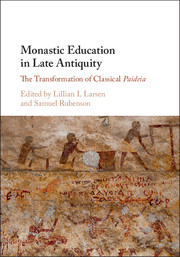Refine search
Actions for selected content:
23990 results in Ancient history
Epilogue
-
- Book:
- Empire and Political Cultures in the Roman World
- Published online:
- 27 July 2018
- Print publication:
- 09 August 2018, pp 155-159
-
- Chapter
- Export citation
Bibliography
-
- Book:
- Empire and Political Cultures in the Roman World
- Published online:
- 27 July 2018
- Print publication:
- 09 August 2018, pp 163-198
-
- Chapter
- Export citation
Chapter 4 - Force and Violence
-
- Book:
- Empire and Political Cultures in the Roman World
- Published online:
- 27 July 2018
- Print publication:
- 09 August 2018, pp 105-133
-
- Chapter
- Export citation
Illustrations
-
- Book:
- Daily Life in Late Antiquity
- Published online:
- 18 June 2018
- Print publication:
- 09 August 2018, pp vi-viii
-
- Chapter
- Export citation
Chapter 1 - Toward a Roman Dialect of Empire
-
- Book:
- Empire and Political Cultures in the Roman World
- Published online:
- 27 July 2018
- Print publication:
- 09 August 2018, pp 18-46
-
- Chapter
-
- You have access
- HTML
- Export citation
Additional material
-
- Book:
- Empire and Political Cultures in the Roman World
- Published online:
- 27 July 2018
- Print publication:
- 09 August 2018, pp xv-xvi
-
- Chapter
- Export citation
4 - The State in Everyday Life
-
- Book:
- Daily Life in Late Antiquity
- Published online:
- 18 June 2018
- Print publication:
- 09 August 2018, pp 125-158
-
- Chapter
- Export citation
Copyright page
-
- Book:
- Daily Life in Late Antiquity
- Published online:
- 18 June 2018
- Print publication:
- 09 August 2018, pp iv-iv
-
- Chapter
- Export citation
Chapter 2 - Territory
-
- Book:
- Empire and Political Cultures in the Roman World
- Published online:
- 27 July 2018
- Print publication:
- 09 August 2018, pp 47-73
-
- Chapter
- Export citation
Introduction
-
- Book:
- Daily Life in Late Antiquity
- Published online:
- 18 June 2018
- Print publication:
- 09 August 2018, pp 1-20
-
- Chapter
- Export citation
Chapter 5 - Time
-
- Book:
- Empire and Political Cultures in the Roman World
- Published online:
- 27 July 2018
- Print publication:
- 09 August 2018, pp 134-154
-
- Chapter
- Export citation

Stories of Daily Life from the Roman World
- Extracts from the Ancient Colloquia
-
- Published online:
- 06 August 2018
- Print publication:
- 31 August 2017
-
- Textbook
- Export citation

Monastic Education in Late Antiquity
- The Transformation of Classical Paideia
-
- Published online:
- 04 August 2018
- Print publication:
- 23 August 2018
Figures
-
- Book:
- Comedy and Religion in Classical Athens
- Published online:
- 16 July 2018
- Print publication:
- 02 August 2018, pp vi-vi
-
- Chapter
- Export citation
Chapter 2 - An Apollonian Beginning
-
- Book:
- Comedy and Religion in Classical Athens
- Published online:
- 16 July 2018
- Print publication:
- 02 August 2018, pp 43-68
-
- Chapter
- Export citation
Chapter 4 - A Household Shrine
-
- Book:
- Comedy and Religion in Classical Athens
- Published online:
- 16 July 2018
- Print publication:
- 02 August 2018, pp 107-136
-
- Chapter
- Export citation
Introduction
-
- Book:
- Comedy and Religion in Classical Athens
- Published online:
- 16 July 2018
- Print publication:
- 02 August 2018, pp 1-10
-
- Chapter
- Export citation
Acknowledgments
-
- Book:
- Comedy and Religion in Classical Athens
- Published online:
- 16 July 2018
- Print publication:
- 02 August 2018, pp vii-ix
-
- Chapter
- Export citation
Bibliography
-
- Book:
- Comedy and Religion in Classical Athens
- Published online:
- 16 July 2018
- Print publication:
- 02 August 2018, pp 181-194
-
- Chapter
- Export citation
Index
-
- Book:
- Comedy and Religion in Classical Athens
- Published online:
- 16 July 2018
- Print publication:
- 02 August 2018, pp 195-202
-
- Chapter
- Export citation
